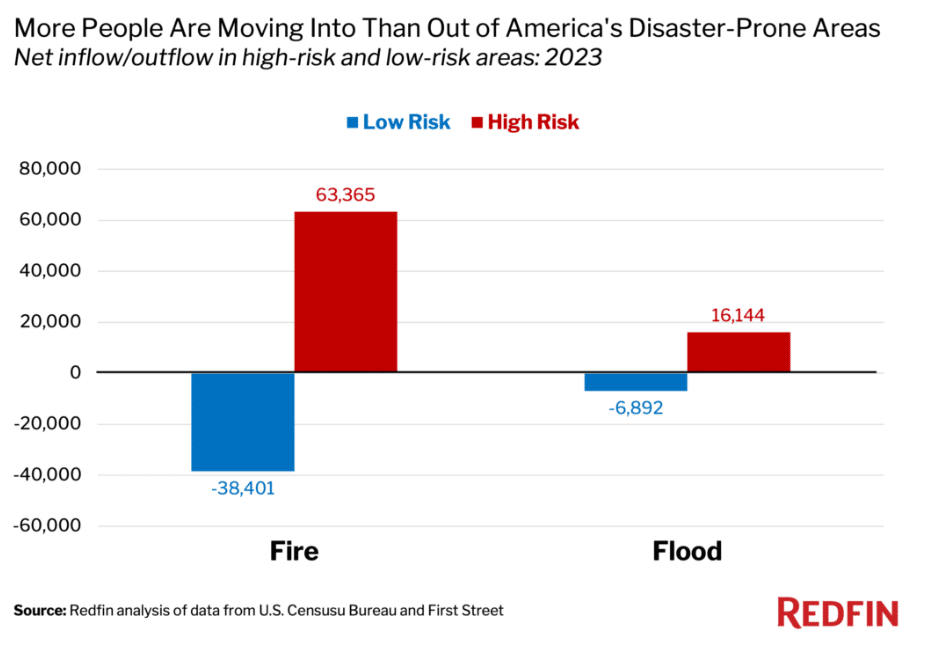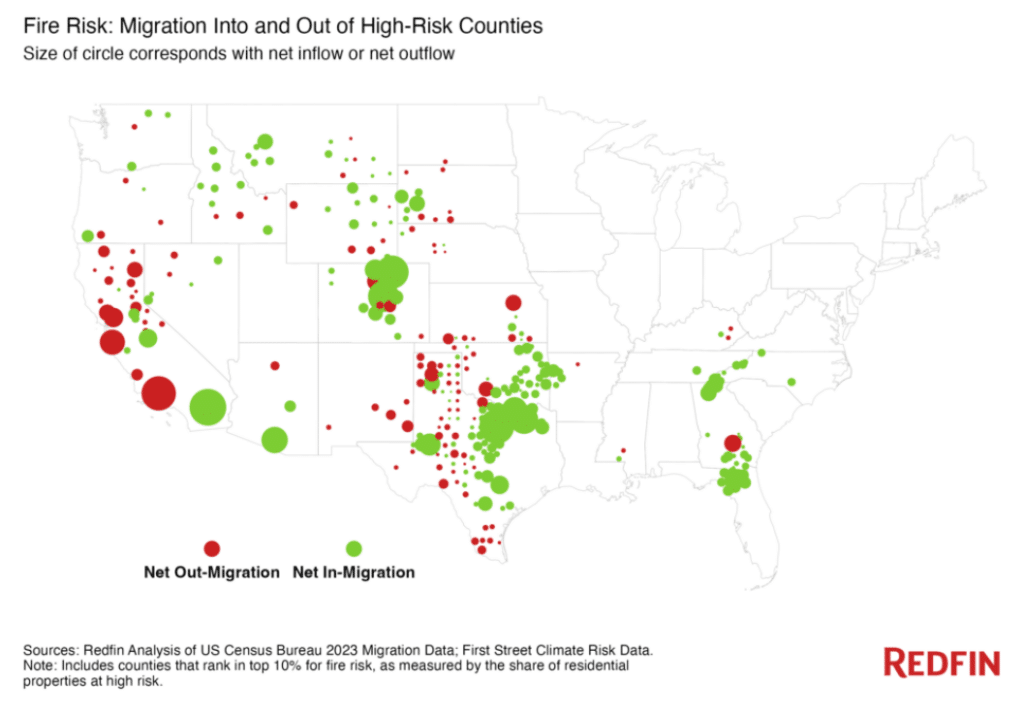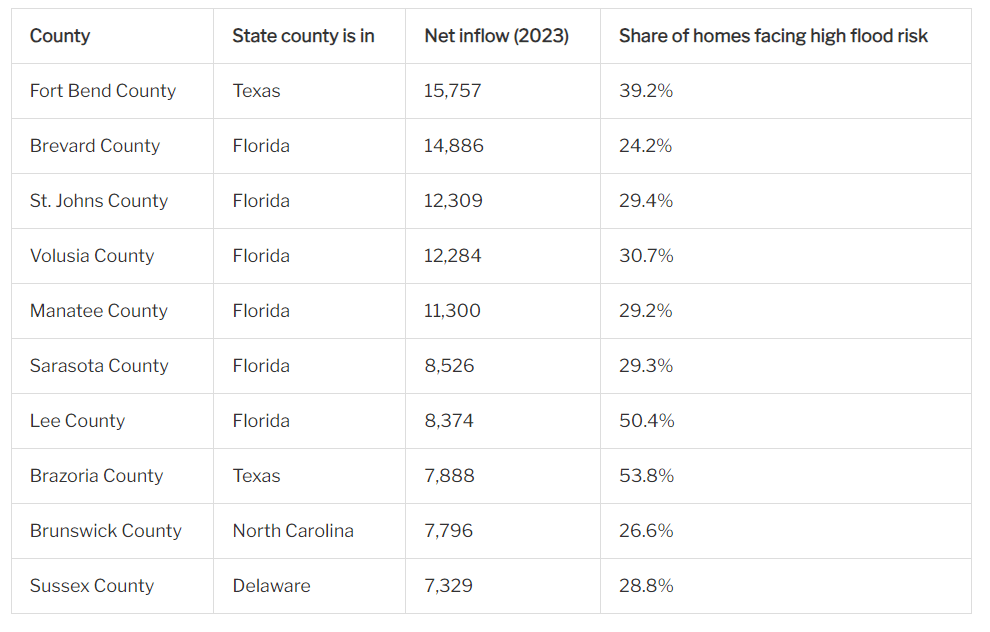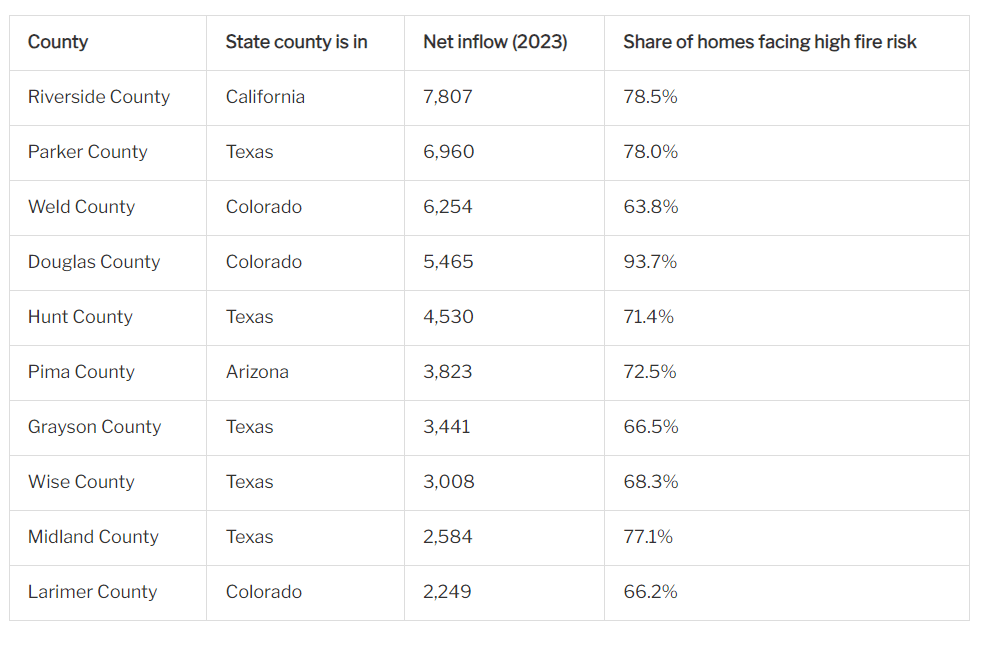A new report from Redfin has found that scores of people are moving to regions of the nation endangered by wildfires, flooding, and extreme heat. America’s high-fire-risk counties saw 63,365 more people move in than out in 2023, with much of that net inflow consisting of those moving to Texas. However, the story differs from state to state, as among California’s high-fire-risk areas, more people left than moved in. This trend marks a reversal from 2022’s data analysis, indicating that people may be growing more responsive to fire risk in the Golden State.
Data for the study is based on a Redfin analysis of domestic migration data from the U.S. Census Bureau and climate-risk scores from First Street. Census migration data for 2023 covers July 2022-July 2023, and Census migration data for 2022 covers July 2021-July 2022. Redfin defines a high-risk county as one that ranks in the top 10% when it comes to the share of homes facing high fire or flood risk.
Meanwhile, for those at risk of flooding, the nation’s high-risk counties saw 16,144 more move in than out, led by the Sunshine State of Florida which drove a large share of the migration to high-flood-risk counties, but a smaller share than it did in 2022.
The opposite occurred in low-risk areas; America’s low-fire-risk counties saw a net outflow of 38,401 people in 2023, and low-flood-risk counties experienced a net outflow of 6,892.

Insurance as a Factor
“Ballooning insurance costs and intensifying natural disasters are driving thousands of Americans out of risky areas, but those people are quickly being replaced by other people for whom climate change isn’t the top concern,” said Redfin Senior Economist Elijah de la Campa. “For a lot of Americans, things like cost of living and proximity to family take precedence over catastrophe risk, which can feel less immediate and more abstract. But the cost-benefit calculus seems to be shifting in places like California and Florida, where skyrocketing home insurance costs and an uptick in high-profile disasters have had a tangible impact on residents and made national news.”
Roughly one in 11 (or 8.8%) people who plan to move soon cited concern over natural disasters or climate risk as a reason, according to a Redfin-commissioned survey. But, other responses were much more common: Wanted more space (32.4%), lower cost of living (26.4%) and to be closer to family (16.4%), to name a few.

Things Heat Up in the Lone Star State
Migration to fire-prone Texas fueled a significant portion of the national net inflow to high-fire-risk areas last year. Here’s the breakdown:
- A total of 97,535 people moved into high-fire-risk U.S. counties, while 34,170 moved out, which is how Redfin got a net inflow of 63,365 in section one.
- 35,175 of the aforementioned 97,535—or 36.1%—were people who moved to Texas. That’s up from 28.7% in 2022. All in all, high-fire-risk counties in Texas saw a net inflow of 30,156—a big chunk of the nationwide net inflow.
- Texas is home to five of the 10 high-fire-risk counties that saw the largest net inflows of people last year. Four of those counties are located in the area surrounding Dallas-Fort Worth, which is home to a lot of state park land.
Texas isn’t often the first state that comes to mind when people consider fire risk, but it had more wildfires last year (7,102) than any state but California (7,364), and actually did have the highest number of wildfires in 2022. Aside from California, the Lone Star State also has the greatest number of homes in the Wildland Urban Interface—the part of the country where developed land intermingles with undeveloped land, making it especially vulnerable to wildfires.
More Fleeing Flood-Prone Houston
Five high-flood-risk counties in Texas had net inflows of more than 2,000 people in 2023. All are just outside of Houston, which last month grappled with flooding and power outages due to Hurricane Beryl, along with sweltering heat.
Harris County, which includes Houston proper and also faces high flood risk, is an outlier. It saw a net outflow of 22,792 people last year. That may partly reflect families moving to the suburbs, which gained popularity during the pandemic as remote work allowed people to prioritize things like big homes and access to nature over proximity to the office.
“The main climate issue in Houston is flooding, but the major factor driving me away is the heat. I don’t want to go through another Houston summer,” Redfin Premier Real Estate Agent Nicole Nodarse said. “But a lot of people are still moving here because they like the low prices and the politics. Homeowners insurance is becoming a big deal, though; it’s much more expensive than it used to be, and a lot of people who installed 30-year roofs are now having to replace them after 15 years because some insurers won’t cover the home if the roof is older than that.”
More Flocking to Soggy Sunshine State
Migration to flood-prone Florida fueled a sizable chunk of the national net inflow to high-flood-risk areas last year. Here’s the breakdown:
- A total of 219,799 people moved into high-flood-risk U.S. counties, while 203,655 moved out, which is how Redfin got a net inflow of 16,144 in section one.
- 117,574 of the aforementioned 219,799—or 53.5%—were people who moved to Florida. All in all, high-flood-risk counties in Florida saw a net inflow of 68,564—contributing significantly to the national net inflow. (The national net inflow is smaller than the Florida net inflow because the Florida net inflow was partly offset by outflows in other areas.)
- While Florida’s impact on the national figure is large, it has shrunk; Florida accounted for 53.5% of migration to high-flood-risk areas in 2023, down from 57.3% in 2022. This could be because people are becoming more aware of flood risk and surging insurance costs.
- Florida is home to six of the 10 high-flood-risk counties that saw the largest net inflows of people last year. All six are located on the Florida coast.

Miami bucks the trend. Miami-Dade County, where 38.9% of homes face high flood risk, saw a net outflow of 47,597 people in 2023. That’s a bigger outflow than almost any other county in the nation. Some people have left due to climate dangers, but many have been priced out due to the surge in housing costs during the pandemic. The median home sale price in the Miami metro area is $555,000, up almost 75% from $319,000 at this time in 2019.
“Miami has gentrified. Many of the people who are selling their homes now are moving elsewhere because they can no longer afford to live here given the rise in interest rates, housing prices, insurance costs and HOA fees for condo dwellers,” said Rafael Corrales, a Redfin Premier Agent in Miami. “A lot of the buyers in the market are paying in cash, which allows them to forgo homeowners insurance. That means they don’t have to deal with skyrocketing premiums, but it also means they’re on their own if a storm hits.”
Florida, along with California, is in the middle of a housing-insurance crisis. Many homeowners have seen their premiums skyrocket, and some have lost coverage altogether because intensifying natural disaster risk has prompted many insurers to stop doing business in the two states. The good news is that homes being built in Florida today tend to be more resilient than older homes because they must adhere to stricter, modern building codes.
“Prospective homebuyers are asking me a lot more questions about natural disasters and insurance costs than they were previously. About three-quarters of the sellers I speak to express frustration over recent increases in their insurance premiums,” Corrales added. “If you’re looking to buy a home in Florida, you should know that you can’t be close to the water without being in a flood zone. If you’re within three miles of the coastline, mother nature is going to pay you a visit. That’s the price you pay for living in paradise.”
A Golden State Exodus
While fire-prone America saw more people move in than leave in 2023, there were still a lot of people who left, and many of them left California:
- A total of 34,170 people left high-fire-risk U.S. counties last year.
- 17,357 of those people—or 50.8%—left California. That’s up from 41.9% in 2022, which may signal that people in the Golden State have grown more responsive to fire risk.
- Overall, California’s high-fire-risk areas saw a net outflow of 6,937 people in 2023. That marks a reversal from 2022, when high-fire-risk counties sa
California is home to five of the 10 high-fire-risk counties that saw the largest net outflows in 2023. Two of those counties are in and around Napa, which has sustained significant wildfire damage in recent years, and another is north of Lake Tahoe, which has also been hit by wildfires. The remaining two are on the coast—one is next to Santa Barbara and one includes the city of Santa Cruz. Many of these counties also have high home prices, which may be pushing some people out of the area.

“We live between the ocean and the bay, with the beautiful coastal mountains between, which means we have high fire risk, flood risk, and always the potential for an earthquake,” said Julie Zubiate, a Redfin Premier Agent in the Bay Area. “I recently had a condo almost fall out of contract because Fannie Mae switched my client from approved to unapproved while under escrow. Fannie Mae decided the home’s HOA wasn’t protected enough from climate disasters. It took awhile, but we found a lender willing to take on the risk—but at a higher cost to my clients.”
Click here for more on Redfin’s latest migration report.





